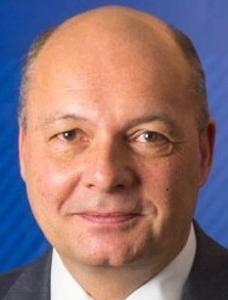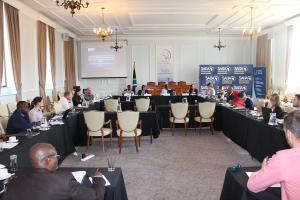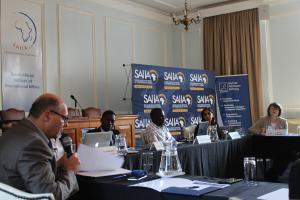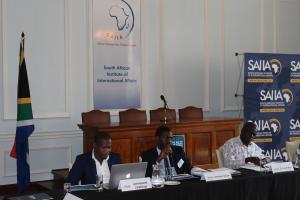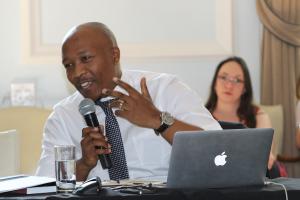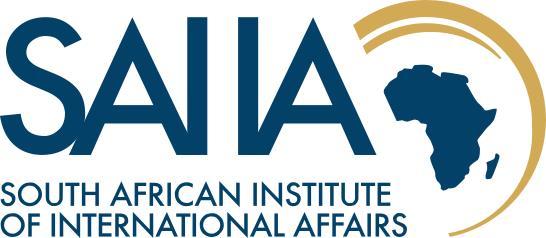SAIIA-KAS Migration Conference - Foundation Office South Africa
Expert conference
Details
SAIIA-KAS Migration Conference
Revisiting the Migration Regimes in the EAC, SADC & COMESA
The SAIIA-KAS Migration Conference took part on Thursday, September 8 2016 at the Jan Smuts House of the University of Witwatersrand in Johannesburg. The conference is part of a series of papers and studies from SAIIA and started with some opening remarks by Neuma Grobbelaar, Director of Research of SAIIA and Dr. Holger Dix, Resident Representative of the Konrad Adenauer Foundation.
Mrs. Grobbelaar explained how migration has reshaped countries and how it has a major impact on the political landscape which can be seen clearly during election times. She took the rise of Europe´s right wing parties and Brexit as an example but at the same time emphasized that there are nevertheless some steps into the right direction. Mrs. Grobbelaar especially mentioned Germany’s brave start of accepting migrants from Syria. South Africa is a key destination for migration and although there are possible negative impacts there are positive impacts as well. Negative impacts could be the outbreaks of xenophobia or the displacement of economic opportunities. However, there is great potential for migration to be beneficial, especially in the areas of technology transfer, closing skill gaps, fostering entrepreneurship and creating jobs.
Dr. Dix began his welcoming remarks with emphasizing the humanitarian imperative and the Christian duty of helping people in need. In a globalized world, migration is an omnipresent process and the growing numbers put us into an ethical dilemma. He described the fact that refugees who are trying to reach the European Union have to pay with their lives as a moral scandal and explained that these deaths call Europe’s credibility and its values into question. One of the great difficulties is that migration not only involves economic migrants but also refugees that see themselves forced to leave their countries which creates the necessity for two different registration and acceptance processes. Another big issue is the integration of the accepted migrants and the social and political impact of the refugee crisis, especially the polarization of the society. As the support of the right wing parties is growing, the pressure on politicians who are ready to help people in need increases as well. Another ethical dilemma is the fact that opening up and facilitating access to the EU will lead to even more people risking their lives in an attempt to reach the EU.
Azwimpheleli Langalanga and Charisma Ncube, both researchers at SAIIA started with the first presentation titled “African Negotiating Positions: Do the Migration Regimes in the EAC, SADC and COMESA Reflect the Members’ Economic Needs?”. The purpose of the research conducted by SAIIA was to explore the different legal regimes in the respective regional economic communities (RECs), to understand the extent of implementation within RECs, to investigate the trade-migration nexus in migration protocols and to assess how migration should be factored into the TFTA. The first part of the presentation was the migration in COMESA. There are four main causes of migration: environmental, social, economic and political causes. Push factors are poverty, fear, disaster, unemployment, economic instability and the fear of prosecution. Attracted by the hope for safety and economic stability, big numbers of migrants come to South Africa. Although the host country benefits through skilled laborers, more revenue, expertise, taxes and technology, the sending countries benefit as well when migrants move back to their country of origin and come back with increased experience and knowledge.
Nevertheless, with the increased numbers of migrants some issues become more and more pressing: The biggest challenges are security issues, the non-ratification of treaties, the uneven compliance and the missing link between migration and trade or economic imperatives. Furthermore, host countries have to fulfill the social security needs of migrants, they have to tackle the issue of terrorism and other security breaches and have to deal with social tension because parts of the population think that foreigners take jobs and other opportunities. In addition, the sending countries have to deal with issues arising from migration as well: they lose skilled laborers and young and talented people as most migrants do not want to come back.
Therefore, it is very important to regulate migration to maximize the benefits and to mitigate the costs. COMESA is the largest regional community in Africa and has implemented the following regional instruments: The Protocol on the Free Movement of Persons, Labor, Services, Right of Establishment and Residence from 1998 and the Protocol on the Gradual Relaxation of and Eventual Elimination of Visa Requirements of 1984. Success was shown through the introduction of one-border post stops, the informal trade movement relaxation and the establishment of port of entry visas.
The second part of the presentation dealt with migration in the East African Community (EAC). The legal regime consists of Art 104 of the Common Market Protocol which allows for free movement of goods, services, capital and labor and the annexure to the CMP on the free movement of persons and labor which sets out rights for migrants. The CMP and the annexure led to the establishment of ministries that are responsible for the EAC, to the establishment of one stop border posts and to harmonized procedures for issuing entry and work permits. In addition, it led to the mutual recognition of qualifications and EAC passports, to the harmonization of employment laws and policies and to bilateral agreements that complement unique conditions between states.
Nevertheless, the implementation has to deal with some serious issues such as the slow implementation by some members, the lack of funds, the poor infrastructure and the language barriers. Lessons to be learned from the EAC are the possibility to harness labor migration as a vehicle for regional development and the Collective Labor Migration Strategy which could be a key to poverty alleviation and employment creation.
The third part of the presentation dealt with migration in the Southern African Development Community (SADC). The current legal framework consists of the Protocol on the Facilitation of Movement of persons from 2005, the Protocol on Employment and Labor from 2014, the regional labor migration policy framework and the SADC Charter of Fundamental Social Rights. However, due to its protectionism, the SADC has not been able to effectively liberalize migration. The SADC faces the following implementation challenges: poor ratification, lack of financial and technical expertise, lack of political will and commitment, lack of harmonization of laws due to the lack of a cleat regional framework and national laws and policies that are used to limit migration.
The next part of the study highlighted the most important parts of the Green Paper. First of all, South Africa has a sovereign right to manage international migration in light of its national interests. Additionally, there is a need to orient the countries international migration policy towards Africa as nation-building and social cohesion are identified as outcomes of the country’s international migration policy. There is a need for this international migration policy to enable South Africans living abroad to contribute to the national development. In conclusion, the Paper must balance the primary imperatives of economic development, national security and international and constitutional obligations.
The next speaker was Dr. Innocent Mayo, Senior Lecturer and Researcher at the University of Zululand. He started by explaining that the question relating to migration regimes within the regional blocks speaks directly to the issue of the African Union (AU) and the establishment of the African Economic Community (AEC) by 2028. The AU defines its approach to migration through two key policy frameworks: The Migration Policy Framework for Africa (MPFA), and the African Common Position on Migration and Development (ACPMD). The MPFA addresses nine key migration issues including labor migration, border management, irregular migration, forced displacement, the human rights of migrants, internal migration, migration data, migration and development, and inter-state cooperation and partnerships. The ACPMD on the other hand raises eleven priority policy issues and recommendations for national, continental and international action. These include migration and development, human resources and the brain drain, remittances, trade, migration and peace, security and stability, migration and human rights, gender, regional initiatives and access to social services. Accomplishing free movement of persons in COMESA, EAC and SADC, therefore, contributes to the realization of the AU’s goals. There are several policy instruments, commissions and declarations by the AU that affect and facilitate migration, but are not specifically crafted to govern it.
Dr. Mayo then continued speaking about the COMESA, EAC and SADC migration regimes. All these regional economic blocks are founded on neoliberal economic thinking. Although there may be variations, the Balassian Model on regional integration appears to influence the direction that these regional blocks are taking. First, integrating countries establish a free trade area (FTA). Second, the integrating countries adopt a common external tariff (CET), which is the basis for the formation of a customs union (CU). Third, the CU progresses to a Common Market. The fourth stage involves the establishment of an economic and monetary union (EMU) based on supranational institutions, which govern economic policies. In the model of integration that these regional blocks follow, migration and especially that of people, capital goods and services is essential.
Made up of 19 members, COMESA was originally a Preferential Trade Area and its formation is based on the Balassian thinking. It is in this regard that it has adopted several instruments and protocols, which are important to the movement of people, goods, capital and services such as the Protocol on the Gradual Relaxation and Eventual elimination of Visa Requirement (Visa Protocol) which targets the free movement of people in the region. However, the effective implementation of the various protocols remains problematic. Other implementations are the one border concept and the harmonization of customs processes.
Made up of 15 member states, the SADC targets regional integration through the Balassian stages of regional integration. The Declaration and Treaty of SADC (1992), aims at the progressive elimination of obstacles to the free movement of capital and labor, goods and services and people. In this regard the SADC has come up with policies and protocols to achieve this. A Draft Protocol on the Facilitation of Movement of Person in SADC has been established in 2005 but is not in full force because of the required minimum of two thirds of ratifications. So there is no regional framework for managing migration in the SADC. There is also an emphasis rather on bilateral than on regional agreement approaches to the issue of migration.
Dr. Mayo concluded that more needs to be done to deepen COMESA and make it an effective vehicle for the continental integration project. In the EC the movement towards regional integration suggests positive steps. It provides lessons for other RECs like the SADC. There is still no migration policy framework in the SADC, individual members follow their own laws and this will not help the SADC and continental integration project and AEC set to be formed in 2028. Free trade and movement of people are pre conditions for regional and continental integration. In the COMESA, EAC and SADC, there are several instruments and protocols aimed at managing migration but the issue is implementation, which appears to conflict with narrow territorial interests. There appears to be tension between free market transnationalism and securitized nationalism – neoliberal orthodoxy versus securitarianism.
The second session was titled “Mapping Economic Migration in COMESA” and started with a presentation held by Mr. Fudzai Pamacheche, TFTA Coordinator for COMESA. He started by explaining how COMESA adopted a developmental integration approach anchored on: internal market integration, infrastructure development and industrialization. He then explained the COMESA instruments on the movement of people. The Heads of State and Government of COMESA recognized in 1984 that their regional integration agenda needed to be supported by free movement of people in the region. In this regard they signed the Protocol Relating to the Gradual Relaxation and Eventual Elimination of Visa Requirements within the Common Market for Eastern and Southern Africa. The Protocol provides that as a first step towards the gradual relaxation and eventual elimination of visa requirements within COMESA, nationals of a Member State holding travel documents shall not be required to obtain visas before traveling to the territory of another Member State and may be granted visas to enter such territory upon the presentation of such travel documents at an official entry point of that Member State. The Protocol provided for a 90-day visa to be issued at the point of entry and that extensions could be sought as necessary. The COMESA Treaty provides that this 1984 Protocol shall remain in force until the Protocol on Free Movement of Persons, Labor, Services, Right of Establishment and Residence enters into force.
COMESA continues to pursue the vision of free cross-border movement within the 19-Member States through relaxation and elimination of visa requirement for travelers. Accordingly, in the COMESA Treaty, the Member States agreed to conclude the COMESA Protocol on the Free Movement of Persons, Labour, Services, the Right of Establishment and Residence. The objective of the Protocol is to ensure that Member States adopt measures that shall gradually and on a step by step basis remove restrictions to free movement of persons, labor, services, right of establishment and residence. This Protocol has to date been signed by four Member States and only one ratification has been deposited, meaning that the protocol has effectively not become actionable.
He then continued to speak about the implementation of migration instruments. The provisions of the protocol went beyond the relaxation of visas to the removal of all forms of restriction on the movement of persons and the right of establishment and residence. It also reinforced the fact that a genuine common market can only be reality when citizens of the region including companies and firms can move freely within the region, are free to take up offers of employment in any Member State, are free to pursue activities of self-employment and set up and manage undertakings in any Member state under conditions similar to those applicable to citizens and companies of the host country.
The benefits of free movement include skills sharing, contribution to economy by migrants such as taxes and technology transfer, business development, access to skills that have been trained elsewhere, etc. Challenges include security, social tensions, delay in concluding mutual recognition agreements on qualifications etc. He concluded that in not taking the right action to allow free movement or migration for that matter tends to ignore the considerable potential for socio-economic growth and development that countries of origin and of destination could derive and also the gains that the individual migrants and their families would achieve if only they could freely move across borders and offer their services.
The next speaker was Boris Mulengu, a mixed migration specialist from Zambia. He started by addressing the background of Zambia´s protection sensitive processes. Zambia is struggling with an increase of irregular migration which has exposed a number of legal and administrative inadequacies in the management of migration. These challenges have necessitated a review of existing mechanism to address protection needs of vulnerable migrants and ease the process of managing migration. The initial challenges in Zambia are inadequate Identification and referral mechanisms, lack of differentiated protection, poor co-ordination among stake holders, fragmented institutional and national guidelines, inadequate shelters for vulnerable migrants, unclear alternative to detention procedures, archaic legislation and procedures, gaps and rigidity in legislation and an unclear guideline between the procedure for handling economic migrants and vulnerable migrants.
He then continued to explain a project from 2013 which is anchored on mixed migration and has revolutionized migration management in Zambia. The Action Plan from that project includes the development of national guidelines for the protection of vulnerable migrants, legal review and the strengthening of institutional and administrative mechanisms for this protection.
The Action Plan is structured around six main areas that emerged from discussions during the Regional Conference: (1) Legislative reform and review of policy, (2) Capacity-building, (3) Operations, (4) Outreach, (5) Data Collection and Analysis and (6) Cooperation and Coordination. General targets are recommended in relation to each area, in order to provide a basis for evaluating progress, when the Regional Conference reconvenes, as proposed, in two years. At the regional level, the African Union (AU) and the Regional Economic Communities (RECs), including the EAC, SADC, IGAD and COMESA, will be important partners in moving the Action Plan forward, providing a platform for continued dialogue and collaboration. Member States to these bodies are encouraged to ensure that issues related to refugee protection and mixed migration are appropriately prioritized and resourced.
An initial monitoring demonstrates strengthened capacity of first line officials & service providers to identify various categories of vulnerable migrants by administering the Profiling Form, to refer migrants to relevant authorities & service providers, to provide appropriate protective services and to enhanced coordination among partners. The achievements include the training of officers, the training of media personal, the training of personnel involved in refugee status determination so they could uphold the rights of asylum seekers and many other improvements including the encouragement of a human rights approach in applying immigration laws.
The third session started with a presentation by JB Cronjé, a researcher for TRALAC. He explained that there are two broad trends in Eastern Africa: From the DRC and Horn of African countries to adjacent neighboring countries because of political instability and conflict and within the EAC itself because of the regional economic integration (EAC Common Market Protocol), the free movement of workers and right of establishment, the mutual recognition of academic and professional qualifications. The general migration trend leads toward South Africa as it is seen as a large and diversified country and therefore the top destination for international migrants in Africa. In addition, South Africa hosts the largest number of refugees and asylum-seekers in Africa (5th largest in world) and migrants are allowed to integrate and work. South Africa is currently developing a new international migration policy in order to bring domestic policy in line with the African development agenda.
The highlights of South Africa´s proposed international migration policy are a risk-based approach to international migration that includes a traveler identification system which allows bona fide travelers long-term multiple entry visas, abolishes transit visas and establishes an integrated border management authority. Another highlight are the more stringent residency and naturalization requirements and the better management of international migrants with skills and capital which includes long-term work visas, preserves family units and allows the issuance of permanent residence or long-term work visas for international students graduating from South African universities. The proposed international migration policy also tries to improve engagement with South African emigrants. In addition, a more stringent asylum-seeker and refugee legislation which includes bilateral agreements with neighboring countries shall be implemented. For the new migration policy, historical and geopolitical migration patterns in Africa have been taken into consideration.
The second speaker in this session was Prof. Tsotetsi Makong, a senior lecturer from Tanzania. He explained that intra-African migrations have gone down and that African migration is slightly shifting from being triggered by poverty, violence and underdevelopment to being driven by processes of development and social transformation. Common issues are the enforcement of laws, the struggle between necessary deportations and their impact on the economy in case skilled workers are deported and the struggle between data capturing and tracking of migrants and legitimate deportations. In addition, another issue is the transfer of knowledge and technology.
The last speaker of the day was Malcom McKinnon, a senior trade advisor to the SADC who focused on the importance of movement of business people. Business mobility allows face-to-face communication and in-person meetings, is the most effective way of meeting new clients, essential for negotiating final agreements, a key factor in building long-term relationships, a key channel for transfer of knowledge and stimulates trade and economic growth. Therefore, impediments to mobility of business people across borders imposes real costs on economies such as reduced imports and exports, reduced FDI stocks, reduced productivity, reduced competitiveness and translates into trade transaction costs for business.
There are two foundations for the Protocol on Facilitation of Movement Persons: The SADC Treaty, which advocates for the “promotion of interdependence and integration of national economies for the harmonious, balanced and equitable development of the region” and the Protocol on Tourism Development, which advocates for the introduction of a tourist Univisa. The development of policies aimed at the progressive elimination of obstacles to the movement of persons in the region, generally into and within the territories of State Parties.
He then continued to talk about the Tripartite Agreement on Movement of Business Persons. The Tripartite Ministers agreed in October 2014 that the Movement of Business Persons should not be incorporated in the TFTA; and that the TTC-MBP should develop content and define the appropriate legal instrument to be used. The Tripartite Agreement provides for up to 90 days’ stay in another Tripartite country, although most countries grant for ordinary citizens of RECs and some countries grant a longer period of up to 180 days. In addition, it allows Member/Partner States to maintain visa requirements between each other, and to grant – or not grant – visas on arrival in accordance with their domestic legislation. Nevertheless, there is no change for business. The Tripartite Agreement allows a great deal of scope for Member/Partner States to interpret the agreement in the way they want and many draft provisions allow Member/Partner States to rely on their national legislation.
Mrs. Bertelsman-Scott, the head of the Economic Diplomacy Programme of SAIIA closed the conference by summarizing the most important issues and the suggested solutions.
Written by KAS Research Assistant Ms Jana Grathwohl.



